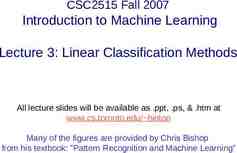Basic Tree Identification Presented by Virginia Department of Forestry
24 Slides4.16 MB
Basic Tree Identification Presented by Virginia Department of Forestry
What is a tree? Woody plant Usually one main stem Exceeds 15 feet in height and 3 inches in diameter at maturity
Tree Identification Features Leaves Bark Twigs Reproductive Overall Form Growing Site Parts
Leaf Characteristics Deciduous or evergreen? Arrangement on stem Simple or compound? Pinnate or palmate leaflets or veins Margins Base and tip features Special characteristics (smell, texture, stipules, glands, etc.)
Leaf Parts Veins (pinnate) Blade Petiole Edge/Margin
Leaf Arrangement Alternate Opposite
Simple vs. Compound Simple – leaf has one part Compound – one leaf has multiple parts (leaflets)
Venation Pinnate – One main vein starting at the petiole, with smaller ones branching off Palmate – Several main veins starting at the petiole, with smaller ones branching off
Lobes Lobe Sinus
Edges or Margins Serrated Entire Doubly Serrated
Needles
What characteristics do you see?
Characteristics?
Characteristics?
Characteristics?
Characteristics?
Characteristics?
Bark Characteristics Terminology Descriptive is somewhat subjective. terms may include smooth, scaly, ridged, furrowed, fissured, platy, blocky, netted, and more!
Characteristics?
Characteristics?
Characteristics?
Twig Characteristics Leaf scar, w/ bundle scars Lenticels (the tiny dots) Pith Terminal bud Lateral bud
Tools to Aid in Identification Your senses – sight, touch, smell Dichotomous keys and field guides Hand lens – because details matter! Optional – sharp knife or clippers
Practice Practice Practice!





























